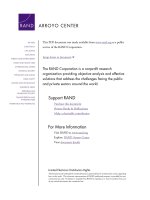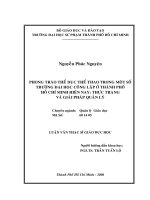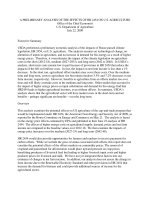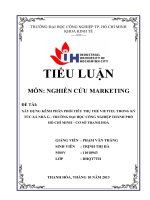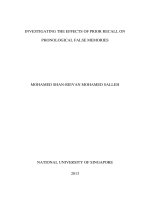The effects of environmental quality on Indonesia’s inbound tourism - Trường Đại học Công nghiệp Thực phẩm Tp. Hồ Chí Minh
Bạn đang xem bản rút gọn của tài liệu. Xem và tải ngay bản đầy đủ của tài liệu tại đây (1.5 MB, 6 trang )
<span class='text_page_counter'>(1)</span><div class='page_container' data-page=1>
<b>International Journal of Energy Economics and </b>
<b>Policy</b>
ISSN: 2146-4553
available at http: www.econjournals.com
<b>International Journal of Energy Economics and Policy, 2021, 11(1), 9-14.</b>
<b>The Effects of Environmental Quality on Indonesia’s Inbound </b>
<b>Tourism</b>
<b>Suharyono, Kumba Digdowiseiso*</b>
Department of Management, University of National, Jakarta, Indonesia. *Email:
<b>Received:</b> 27 July 2020 <b>Accepted:</b> 05 November 2020 <b>DOI:</b> /><b>ABSTRACT</b>
In recent years, Indonesia’s inbound tourism grew slowly. This study examined the effects of quality of environment on inbound tourism in 32 provinces
over the period 2009-2018. We utilized several indices of environmental quality such as water quality index (WQI), air quality index (AQI), and
environmental quality index (EQI). Meanwhile, our dependent variable, inbound tourism, is measured in terms of incidence and duration of stay. Previous
studies acknowledged that there was a potential endogeneity between quality of environment and tourism. Therefore, instrumental variable (IV) in a static
panel dataset was carried out in the estimation. The results showed that both WQI and EQI were positively and significantly correlated with the demand
for inbound travelers. Furthermore, we found that there was a positive and significant relationship between AQI and length of stay of inbound visitors.
<b>Keywords:</b> Environmental Quality; Inbound Tourism; Indonesia
<b>JEL Classifications:</b> Q500, Q530, Z300
<b>1. INTRODUCTION</b>
Given to the COVID-19 global pandemic that already disrupted
tourism industry in every corner of the world, many travelers visit
Indonesia every year for several leisure activities such as culture,
language, food, world heritage sites, and marvelous scenery.
The growth of tourism sector has trickled down to other sectors
such as hotel, restaurant, transportation, and retail. According
to the Central Bureau of Statistics (BPS), the total contribution
of tourism sector to Indonesia’s Gross Domestic Product (GDP)
accounted for around 4% of the total economy in 2018. As stated
in the 2019 National Action Plan of Tourism, in the next 5 years,
the Government of Indonesia (GoI) planned to double this number
to 8% of GDP. This ambitious plan indicates that Indonesia needs
to attract more domestic and foreign visitors, lifting the current
number of inbound tourists to double to about 20 million.
Moving to the performance of tourism sector in Indonesia, Figure 1
shows that the number of inbound tourists in Indonesia improved
significantly between 2009 and 2018. On the early of 2009, a
series of terrorist attacks, specifically targeted to the foreigners,
seemingly halted the arrival of foreign tourists in Indonesia. From
2009 onwards, with the improved capacity of the country’s special
counter-terrorism squad, the GoI managed to ensure the issue of
national security. Such a condition brings a positive impact on the
Indonesia’s macroeconomic growth, particularly related to travel
and tourism sector. However, as the COVID-19 global pandemic
forced more countries to carry out travel restrictions, the arrival
of foreign tourists in Indonesia plunged around 90% to just about
160 thousand in June 2020 (BPS, 2020). Therefore, one predicts
that tourism sector in Indonesia will need at least 2 years from the
beginning of 2020 to be fully recovered.
In spite of the positive trend on inbound tourism, Figure 2 reveals
that the duration of stay of inbound tourists in Indonesia declined
significantly from 2009 to 2018. Such a trend is somehow
counterintuitive as the 2019 World Economic Forum’s Report
on travel and tourism highlighted several factors that made
Indonesia’s position jumped from rank 42nd<sub> in 2017 to 40</sub>th<sub> in </sub>
2019. Those were related to the improvement in the indicator
</div>
<span class='text_page_counter'>(2)</span><div class='page_container' data-page=2>
of enabling environment, which constitutes health and hygiene,
human resources and labour marker, safety and security, ICT
(information, communication, and technology) readiness, and
business environment, as well as the indicator of natural and
cultural resources that correspond to biodiversity and the presence
of several heritage sites. Beside those indicators, Indonesia had
several competitive advantages in terms of price, international
openness, and prioritization of travel and tourism. However,
the report stated that Indonesia must put their attention on
infrastructure sector since it is still categorized as a persistent
problem that can deteriorate investment climate.
Apart from connectivity issue, the report also stated that Indonesia
did not place enough emphasis on the issue of environmental
sustainability. For example, the GoI only treated a minimal
fraction of the used water and waste recycle, while both policy
and implementation in managing deforestation and protecting
the endangered species were limited (Waluyo et al., 2019;
Digdowiseiso and Sugiyanto, 2020). Hence, both central and
local government should take environmental quality as a crucial
determinant in the decision-making process of potential tourists
since it can determine the competitiveness of tourism destination
(Zhang et al., 2015; Becken et al., 2017). However, in developing
countries with some prominent tourist destinations, improving
quality of environment can be a major challenge as they already
faced other problems such as urbanization, population pressure,
and industrialization. According to Chen et al. (2017), besides
the existing environmental problems such as waste disposal and
water pollution, air pollution has long been regarded as a universal
concern that received a major proportion within environmentalists
around the world. Thus, instead of the quantity, policymakers
should put more attention on the quality of economic growth,
which is partly determined by the performance of natural
environment.
Based on the aforementioned background, our study aims to
fill the gap in the current literatures by examining the effect of
environment quality on Indonesia’s inbound tourism over the
period 2009<i>-</i>2018 comprehensively. Almost all of empirical studies
only examine the impact of air pollution and or air quality index on
tourism (Dong et al., 2019; Xu and Dong, 2020). While few studies
neglect another environmental aspect such as water pollution
and or water quality index as a driver of tourism. Therefore, our
study will provide a thorough investigation between quality of
environment and inbound tourism. Additionally, with regards to
our dependent variable (i.e. tourism), our study can be viewed
as a complementary research that specifically focusses on the
number of visitors (Chen et al., 2017; Keiser et al., 2018; Liu
et al., 2019). In this regards, we argue that the level of tourism
affected by environmental quality can be measured in terms of
visitors’ incidence and their duration of stay. Hence, this study
will not only capture the possible heterogeneities among groups
of tourist, but it will also explain the decision-making process of
inbound tourists. Moreover, our study will take into account the
issue of endogeneity between environmental quality and tourism.
By incorporating several control variables in the estimation, our
study thus will provide a more accurate and reliable result.
The rest of the paper is organized as follows: Section I depicts
literature review on environment quality and tourism. Section II
presents the data and methodology used in this research. Section
III reports empirical results based on the econometric model. We
also provide concluding remarks as the next section.
<b>2. LITERATURE REVIEW ON </b>
<b>ENVIRONMENTAL QUALITY AND </b>
<b>TOURISM</b>
In principle, the development of tourism can be driven by the
sustainability of natural resources in a country such as water
and forestry (Gössling and Hall, 2006). Thus, policymakers
should optimize the use of environment to promote economic
development. Some studies examine the impact of environmental
quality on economic growth (Oh, 2005; Lee and Chang, 2008).
Those particular investigations show that tourism was not a
superior good and service. Rather, it was widely enjoyed by the
general public as a secondary one. Albeit for the tourism<i>-</i>growth
nexus, it is important to note that the perception of visitors on
<b>Figure 1:</b> Trend on Indonesia’s inbound tourists
Source: Authors’ calculation
<b>Figure 2:</b> Length of visit of inbound tourists
</div>
<span class='text_page_counter'>(3)</span><div class='page_container' data-page=3>
tourism industry has changed dramatically, where the changes
in climate or weather conditions can be a main driver of tourism
(Sajjad et al., 2014; Wang et al., 2018). On one side, should the
environmental quality in the host country are in critical condition,
the number of inbound tourists will reduce. On the other side, if
the conditions of environment in the home country are poor, then
this will increase the number of outbound visitors. Therefore, the
impact of environmental quality on tourism can be measured in
terms of source of a country.
The relationship between quality of environment and tourism
becomes much more interesting and complex when the estimations
utilize various metrics of tourism. In this context, some studies
lay stress on individual visitors such as travel behaviour, travel
intention, and destination choice (Becken et al., 2017), well-being
and quality of life (Agarwal et al., 2018), visitors’ satisfaction (Wu
et al., 2018), and the image of destination (Peng and Xiao, 2018).
Meanwhile, others draw attention to the demand of global tourist
such as the arrival of tourists (Zhou et al., 2018), the number of
visitors (Liu et al., 2019), international tourism receipts (Sajjad
et al., 2014), urban activities (Yan et al., 2019), and the demand of
outbound tourists (Wang et al., 2018. In this study, our investigation
will put emphasis on global tourist demand, particularly related to
number of inbound visitors and their duration of stay.
As explained in the previous section, many empirical studies
put their concerns on air quality and or air pollution as a proxy
of quality of environment. Clearly, haze pollution not only
deteriorates the visibility of air, but it also lowers tourists’ health.
These phenomenon bring a negative effect on the tourists’ travel
experiences. Consequently, quality of air is a major determinant to
the sustainability of tourism in a country. Since the daily trend of
haze pollution levels appears to be increasing in some developing
and developed countries, many empirical studies have tried to
examine the effect of air pollution on tourism. A consensual
conclusion is that air pollution significantly reduces the number
of inbound tourists (Anaman and Looi, 2000).
Basically, studies on the air pollution<i>-</i>tourism nexus can be
elaborated in terms of micro and macro perspective. In the former
(i.e. a micro-level), based on a survey of China residents in the
U.S. and Australia, Becken et al. (2017) proved that the perceived
risk of air quality in China is negatively correlated with the plan
to visit and image of destination. In line with this argument, Peng
and Xiao (2018) found a significant negative effect of air pollution
on travel satisfaction and destination image. Meanwhile, in the
latter (i.e. a macro-level), Deng et al. (2017) showed that the
industrial gas emissions in provinces of China were significantly
and negatively correlated to the inbound tourism industry. In
another study, Xu and Reed (2017) highlighted a high level of air
pollution that contributed to a low degree of inbound tourism in
China. Meanwhile, a statistical evidence presented by Zhou et al.
(2018) shows that a percentage point increase in the air pollution
index will reduce the number of inbound tourist arrivals by 0.25%.
Following the logic of these aforementioned studies, we
hypothesize that the quality of environment in Indonesia, measured
by air and water quality index, is positively and significantly
correlated with the number of inbound tourists and their duration
of visit. Additionally, since the previous examinations failed to
incorporate the endogeneity issue of environmental quality, that
led to either an overestimation or an underestimation of the results,
in this study, we take reverse causality into estimations in a static
panel dataset.
<b>3. DATA AND EMPIRICAL FRAMEWORK</b>
In this study, the annual records of Indonesia’s inbound tourism
and duration of stay are obtained from Indonesia’s Central Bureau
of Statistics (Table 1). We also incorporate information about
number of accommodation and rainy days, crime rates, levels
of population, GRDP (Gross Regional Domestic Product) per
capita, and size of road network over the period 2009-2018 from
the National Socio-Economic Survey (SUSENAS, Survei Sosial
Ekonomi Nasional) at inter-regional level in Indonesia, which is
compiled by the national statistical agency (BPS, Badan Pusat
Statistik). In addition, we utilize several metrics of environmental
quality such as water quality index (WQI), air quality index (AQI),
and environmental quality index (EQI) over the period 2009-2018
from the collaboration project between Indonesia’s Ministry
of Environment and Forestry and BPS. Moreover, we also use
sanitation index resulted from a joint research between Indonesia’s
Ministry of Public Works and BPS over the period 2009-2018.
With regards to Table 2, it is clear that on average, the number of
inbound tourists in Indonesia is relatively good, while the average
of length of stay for each province is quite high. On indicator of
environmental quality, despite the presence of a modest level
of EQI and a higher-than-average level of AQI, both WQI and
sanitation levels are in critical level. The crime rates, number
of rainy days and accommodation, and size of road network are
<b>Table 1: List of variables on tourism equation</b>
<b>Variable </b>
<b>name</b> <b>Description</b> <b>Variable Source</b>
lintou Natural logarithm of total
inbound tourists Central Bureau of Statistics
tdos Total duration of stay of
inbound tourists Central Bureau of Statistics
ipa Water quality index (WQI) Central Bureau of
Statistics
ipu Air quality index (AQI) Central Bureau of
Statistics
iklh Environmental quality index
(EQI) Central Bureau of Statistics
laccom Natural logarithm of
accommodation Central Bureau of Statistics
lcrime Natural logarithm of crime rates Central Bureau of
Statistics
lrain Natural logarithm of number of
rainy days Central Bureau of Statistics
san Sanitation index Central Bureau of
Statistics
lroad Natural logarithm of road
network size Central Bureau of Statistics
lgrdppc Natural logarithm of GRDP per
capita Central Bureau of Statistics
lpop Natural logarithm of population Central Bureau of
</div>
<span class='text_page_counter'>(4)</span><div class='page_container' data-page=4>
also, on average, quite moderate. Such conditions are attenuated
by higher-than-average levels of GRDP per capita and levels of
population.
Moving to the quality of environment<i>-</i>inbound tourism nexus
in Indonesia, Figure 3 exhibits a negative trend. This simple
correlation among two variables may give a hint that both
domestic and foreign visitors are not able to perceive the level of
environment quality in Indonesia. In other words, most of inbound
travelers have no information about this condition before traveling
(Liu et al., 2019).
In contrast, Figure 4 shows the environmental quality<i>-</i>length of
stay relationship in Indonesia. In a simple correlation, all metrics
of quality of environment are positively associated with duration
of stay of inbound travelers. The result does not come as a
surprise. Based on the logic of empirical studies, the better levels
of environmental quality in a country, the longer the duration of
stay from inbound tourists.
In estimating the effect of environmental quality on tourism, we
utilize the instrumental variable (IV) in a static panel dataset to
mitigate the issue of reverse causality. In this context, we use
regional dummy since the development of infrastructure mostly
took place in the island of Java, which finally affects environmental
quality. Furthermore, natural logarithm of distance is employed
in the estimation since the geographical distance between capital
cities of province and theirs states determine the degrees of
investment, which in turn affect quality of environment.
The dependent variable of Tou<sub>it</sub> is measured in terms of incidence
of inbound tourists and length of stay. Therefore, the following
benchmark model at cross-province level will be used:
Tou<sub>it</sub> = β<sub>0</sub> + β<sub>1</sub>EQ<sub>it </sub>+ β<sub>2</sub>X<sub>it</sub> + ɛ<sub>it</sub> (1)
where the subscript i denotes the province; t denotes observation
period, which is 2009-2018; X<sub>it</sub> is a vector of control variables
that are assumed to have an influence on tourism; and ε<sub>it</sub> is the
corresponding error term. The main interest throughout this article
lies in the coefficient β<sub>1</sub>, which measures the impact of the quality
of environment on tourism.
The control variables are based on the current literatures related
to the drivers of tourism in many countries—such as number of
accommodation and rainy days, sanitation index, crime rates,
levels of population, GRDP (Gross Regional Domestic Product)
per capita, and size of road network (Dong et al., 2019; Xu and
Dong, 2020).
<b>4. EMPIRICAL RESULTS</b>
The regression results are listed in Table 3, which shows various
determinants of inbound tourism measured in terms of incidence
(from equation 1 to 3) and duration (from equation 4 to 6). In
the former (i.e. incidence), it is important to note that both water
quality index (WQI) and environmental quality index (EQI) were
significantly and positively correlated with number of inbound
tourists. The estimated coefficient implies that a one additional
point increases in WQI and EQI, the demand for inbound tourism
will increase by 1 % and 3 %, ceteris paribus respectively. In
terms of control variables, as expected, the number of rainy days
were significantly and negatively correlated with number of
<b>Table 2: Summary of statistics on tourism equation</b>
<b>Variables</b> <b>Obs</b> <b>Mean Std. deviation</b> <b>Min</b> <b>Max</b>
lintou 320 13.36 1.25 9.81 15.98
tdos 320 9.11 2.26 4.83 17.76
ipa 320 57.44 19.87 0 100
ipu 320 87.83 8.81 50.65 99.76
iklh 320 67.62 10.45 43.67 99.32
laccom 318 3.35 1.25 0 6.31
lcrime 320 5.07 0.59 2.64 6.32
lrain 320 5.13 0.27 4.22 5.62
san 320 57.49 15.03 14.98 91.14
lroad 320 3.57 0.79 1.60 5.05
lgrdppc 320 10.10 0.66 7.86 11.80
lpop 320 15.24 0.99 13.51 17.70
Source: Authors’ calculation
<b>Figure 3:</b> Relationship between environmental quality and inbound tourism
</div>
<span class='text_page_counter'>(5)</span><div class='page_container' data-page=5>
inbound tourists. Meanwhile, there was a significant and positive
association between quality of sanitation, GRDP per capita,
number of population, and the demand for inbound tourism.
In the latter (i.e. duration), we found that air quality index (AQI)
was significantly and positively correlated with length of stay of
inbound travelers in Indonesia. Precisely, it indicates that a one
additional point increases in AQI will rise the duration of stay of
visitors by 0.73 day, holding other variables fixed. On other control
variables, similar to the previous estimations, there was a significant
and negative association between number of rainy days and length
of stay. In contrast, quality of sanitation, GRDP per capita, and
number of population were all significant and positive to duration
of stay of travelers. All in all, our results are somewhat consistent
with the logic of other studies which use air quality index (AQI)
as a proxy of environmental quality (Wang et al., 2018; Yan et al.,
2019). By implementing their analogy, when local air pollution
became worse, it could stimulate the demand for outbound tourism.
<b>5. CONCLUSION</b>
In this study, we investigated the effect of environmental quality
on inbound tourists in 32 provinces of Indonesia over the period
2009<i>-</i>2018 through the use of instrumental variable (IV) technique.
Our estimation showed that quality of environment, measured by
WQI and EQI, was positively and significantly correlated with the
demand for inbound travelers. Furthermore, we found that there
was a positive and significant relationship between AQI and length
of stay of inbound visitors.
Our study is bound by certain limitations. First, our study does
not capture the certain components of pollutant that form AQI
such as concentration of PM<sub>2.5 </sub>and PM<sub>10</sub>. The relative importance
of difference pollutants will assist policymakers to identify
and facilitate the design of efficient policies. Thus, the work
will improve significantly if those data become available in the
nearer future. Last, this study focusses on several metrics of
environmental quality, but these indicators do not sufficient enough
to capture other dimensions of pollution, such as noise pollution,
which may affect tourism. Therefore, a comprehensive measure
of environmental quality can evaluate precisely the impact of
pollution and or quality of environment on tourism.
<b>6. ACKNOWLEDGEMENTS</b>
The authors convey a big gratitude to fellow colleagues from
Department of Management, University of National for the inputs
and comments during our seminar.
<b>Table 3: Instrumental variable (IV) on tourism equation</b>
<b>Ind. </b>
<b>variables</b> <b>Dep. variable: lintou(1)</b> <b>(2)</b> <b>(3)</b> <b>(4)Dep. variable: tdos(5)</b> <b>(6)</b>
ipa 0.01**
(0.007) (0.03)−0.12
ipu −0.33
(0.71) 0.73**(0.22)
iklh 0.03*
(0.01) (0.15)−0.13
laccom −0.16
(0.14) (1.62)0.57 −0.28(0.24) (0.48)0.20 −1.44(2.71) (0.77)0.46
lcrime −0.08
(0.08) (1.24)−0.56 −0.06(0.10) (0.34)0.45 (1.59)1.53 (0.35)0.40
lrain −0.46***
(0.18) (1.77)−1.12 −0.72**(0.38) (0.97)−1.07 −0.41**(0.12) (1.45)−0.49
san 0.009**
(0.005) (0.03)0.02 (0.009)0.005* (0.01)0.02 (0.09)0.05* (0.02)0.008
lroad −0.28
(0.31) (2.07)−0.72 −0.48(0.57) (2.07)−0.70 −0.29(5.56) (0.71)−0.24
lgrdppc 0.096**
(0.42) (1.52)0.36 1.50**(0.69) (1.97)1.93 (4.15)3.27* (2.69)0.73
lpop 4.46***
(1.84) (5.91)5.94 (1.25)2.08* (5.56)4.77 (1.21)1.46* (8.35)10.10
Provincial
FE Yes Yes Yes Yes Yes Yes
Year FE Yes Yes Yes Yes Yes Yes
Observation 318 318 318 318 318 318
Group 32 32 32 32 32 32
Within
R-squared 0.55 0.51 0.53 0.20 0.23 0.18
Number of parentheses are robust standard error. Asterisks denote: *** = significant at
1%; **= significant at 5% level; * = significant at 10 % level
<b>Figure 4:</b> Relationship between environmental quality and duration of stay
</div>
<span class='text_page_counter'>(6)</span><div class='page_container' data-page=6>
<b>REFERENCES</b>
Agarwal, S., Wang, L., Yang, Y. (2018), Blessing in Disguise?
Environmental Shocks and Performance Enhancement. Shanghai
Tech SEM Working Paper No. 2018-012. Available from: http://
www.ssrn.com/abstract=1330752. [Last accessed on 2020 May 24].
Anaman, K., Looi, C. (2000), Economic impact of haze-related air
pollution on the tourism industry in Brunei Darussalam. Economic
Analysis and Policy, 30(2), 133-143.
Badan Pusat Statistik (BPS). (2020), Berita Resmi Statistik 02 Juni
2020. Available from: />materiBrsInd-20200602114424.pdf. [Last accessed on 2020 Jun 18].
Becken, S., Jin, X., Zhang, C., Gao, J. (2017), Urban air pollution in
China: Destination image and risk perceptions. Journal of Sustainable
Tourism, 25(1), 130-147.
Chen, C.M., Lin, Y.L., Hsu, C.L. (2017), Does air pollution drive away
tourists? A case study of the sun moon lake national scenic area,
Taiwan. Transportation Research Part D: Transport and Environment,
53, 398-402.
Deng, T., Xin, L., Mulan, M. (2017), Evaluating impact of air pollution on
China’s inbound tourism industry: A spatial econometric approach.
Asia Pacific Journal of Tourism Research, 22(7), 771-780.
Digdowiseiso, K., Sugiyanto, E. (2020), The effects of multinational
companies on deforestation: The building block or stumbling block.
Journal of Environmental Management and Tourism, 41(1), 5-11.
Dong, D., Xu, X., Wong, Y.F. (2019), Estimating the impact of air pollution
on inbound tourism in China: An analysis based on regression
discontinuity design. Sustainability, 11(6), 1682-1700.
Gössling, S., Hall, C.M. (2006), Uncertainties in predicting tourist flows
under scenarios of climate change. Climatic Change, 79, 163-173.
Keiser, D., Lade, G., Rudik, I. (2018), Air pollution and visitation at US
national parks. Science Advances, 4(7), eaat1613.
Lee, C.C., Chang, C.P. (2008), Tourism development and economic growth:
A closer look at panels. Tourism Management, 29(1), 180-192.
Liu, J., Pan, H., Zheng, S. (2019), Tourism development, environment
and policies: Differences between domestic and international tourists.
Sustainability, 11(5), 1390-1405.
Oh, C.O. (2005), The contribution of tourism development to economic
growth in the Korean economy. Tourism Management, 26(1), 39-44.
Peng, J., Xiao, H. (2018), How does smog influence domestic tourism
in China? A case study of Beijing. Asia Pacific Journal of Tourism
Research, 23(12), 1115-1128.
Sajjad, F., Noreen, U., Zaman, K. (2014), Climate change and air pollution
jointly creating nightmare for tourism industry. Environmental
Science and Pollution Research, 21(21), 12403-12418.
Waluyo, T., Digdowiseiso, K., Putera, E.A.B., Sugiyanto, E. (2019),
The costs of reduction emission from deforestation and forest
degradation: Concepts and issues. Journal of Environmental
Management and Tourism, 10(1), 63-72.
Wang, L., Fang, B., Law, R. (2018), Effect of air quality in the place
of origin on outbound tourism demand: Disposable income as a
moderator. Tourism Management, 68, 152-161.
Wu, M.Y., Pearce, P.L., Li, Q. (2018), Chinese behind the wheel: Factors
affecting their satisfaction with international self-drive holidays.
Journal of Destination Marketing and Management, 9, 12-19.
Xu, B., Dong, D. (2020), Evaluating the impact of air pollution on China’s
inbound tourism: A gravity model approach. Sustainability, 12(4),
1456-77.
Xu, X., Reed, M. (2017), Perceived pollution and inbound tourism in
China. Tourism Management Perspective, 21, 109-112.
Yan, L., Duarte, F., Wand, D., Zheng, S., Ratti, C. (2019), Exploring the
effect of air pollution on social activity in China using geotagged
social media check-in data. Cities, 91, 116-125.
Zhang, A., Zhong, L., Xu, Y., Wang, H., Dang, L. (2015), Tourists’
perception of haze pollution and the potential impacts on travel:
Reshaping the features of tourism seasonality in Beijing, China.
Sustainability, 7(3), 2397-2414.
</div>
<!--links-->
